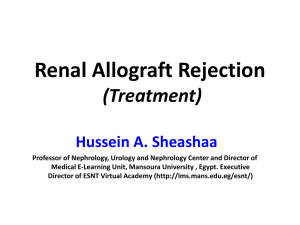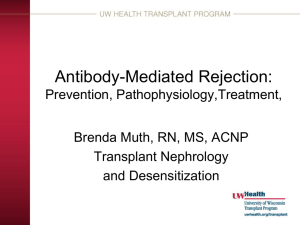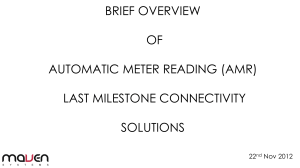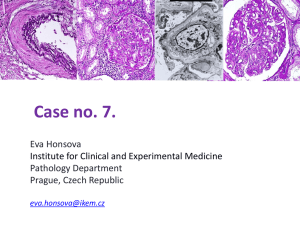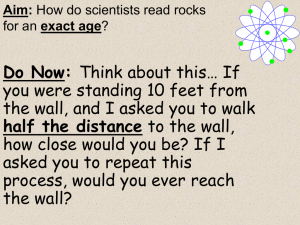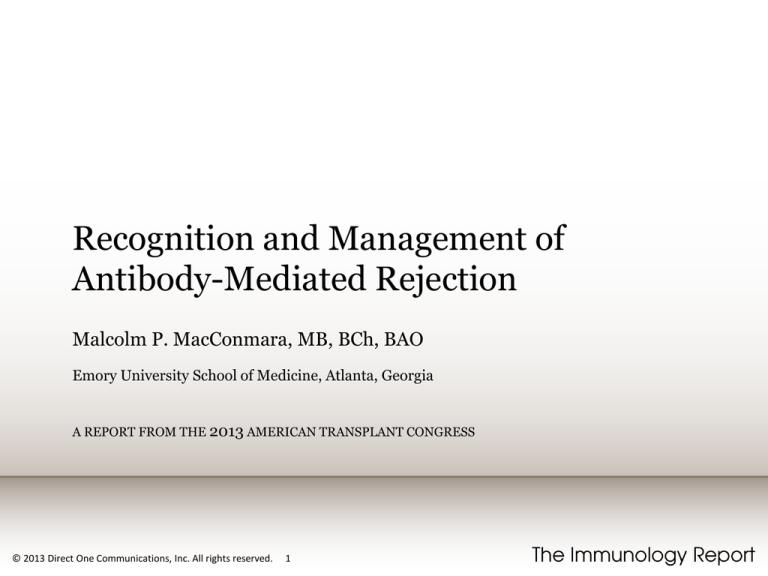
Recognition and Management of
Antibody-Mediated Rejection
Malcolm P. MacConmara, MB, BCh, BAO
Emory University School of Medicine, Atlanta, Georgia
A REPORT FROM THE 2013 AMERICAN TRANSPLANT CONGRESS
© 2013 Direct One Communications, Inc. All rights reserved.
1
Antibody-Mediated Rejection (AMR)
AMR is a major cause of acute and chronic allograft
dysfunction1,2
» Acute AMR occurs in at least 5%–7% of all kidney transplant
recipients and 25%–30% of presensitized crossmatchpositive patients.3
» Chronic AMR due to sensitization or de novo donor-reactive
antigen contributes to long-term allograft loss.2,4
AMR may result from reactivation of antibody
responses to preexisting antigens (type I) or de novo
to donor-specific antibodies (DSAs) encountered late
after transplant (type II), mostly as a result of
nonadherence to immunosuppressive therapy.5
© 2013 Direct One Communications, Inc. All rights reserved.
2
The Difficult Diagnosis of AMR
The current Banff classification of AMR relies upon
three cardinal features: (1) positive C4d staining,
(2) circulating DSA, and (3) tissue injury.
Histologic findings of injury vary.
Classification is based on clinical setting, underlying
pathophysiology, and temporal relationship to
transplantation (hyperacute, acute, and chronic).
Clinical manifestations range from immediate graft
loss to chronic subclinical rejection with gradual loss
of function.1–3
© 2013 Direct One Communications, Inc. All rights reserved.
3
Outcomes Associated with AMR
AMR has a worse outcome than acute cellular
rejection (ACR), likely because of diagnostic
difficulty and less-effective therapeutic options.
Among renal transplant recipients with AMR,
15%–20% lose their grafts within 1 year.6
More than 40% of patients with AMR eventually
develop transplant glomerulopathy, whether or not
initial treatment can reverse acute renal functional
impairment.
AMR-related glomerulopathy is associated with
< 50% 5-year graft survival from the time of
identification.6
© 2013 Direct One Communications, Inc. All rights reserved.
4
Targets and Therapies
Development of antibody-mediated rejection1
MMF = mycophenolate mofetil; TH cell = T-helper cell; IVIg = immunoglobulin-
© 2013 Direct One Communications, Inc. All rights reserved.
5
Targets and Therapies
Therapeutic options for AMR1,2,7 include:
Inhibition or depletion of B-cell function with
rituximab or corticosteroids
Interference with antibody function using
plasmapheresis, immunoadsorption, and/or
intravenous immunoglobulin (IVIg)
Interruption of plasma-cell function with bortezomib
Prevention of complement cascade using eculizumab
© 2013 Direct One Communications, Inc. All rights reserved.
6
The Population and the Risks
Over 96,000 patients currently are registered on the
waiting list for kidney transplantation.
» Almost 16% are prior organ-transplant recipients.
» Approximately 30% are sensitized to human leukocyte
antigen (HLA).8
» Highly sensitized patients with > 80% panel-reactive
antibody (PRA) wait three times longer to undergo
transplant surgery than do unsensitized renal transplant
recipients and have an average wait time of almost 10
years.9
Desensitized patients continue to have an increased
incidence of type I AMR and graft loss.10
© 2013 Direct One Communications, Inc. All rights reserved.
7
Pathophysiology in Sensitized Patients
Type I AMR in desensitized patients apparently
involves residual plasma cells and long-lived
allospecific memory B cells.11
Approximately one fourth of desensitized recipients
experience early AMR, usually within the first week
after transplant.12
Two thirds of these patients respond to
plasmapheresis.
The remainder may experience severe oliguric,
plasmapheresis-resistant rejection, which often is
accompanied by graft loss.
© 2013 Direct One Communications, Inc. All rights reserved.
8
Pathophysiology in Sensitized Patients
The principal effector mechanism of antibody-mediated
injury involves activation of the classic complement
pathway by the antigen-antibody complex deposition.13
Ig = immunoglobulin; HLA = human leukocyte antigen; DAF = decay-accelerating factor; Y-CVF = Yunnan-cobra venom factor
© 2013 Direct One Communications, Inc. All rights reserved.
9
Treatment of AMR: Plasmapheresis
Montgomery et al14 used plasmapheresis with IVIg to
reduce DSA strength before transplantation.
Induction with antithymoglobulin and steroids with
maintenance immunosuppression (tacrolimus and
mycophenolate mofetil) prevented AMR in most
desensitized patients.
» One third received anti-CD20 immediately before
transplant.
» Desensitization improved patient survival to 90% and 80%
at 1 and 5 years, respectively, as compared with 93% and
65% among those waiting for compatible donors.
© 2013 Direct One Communications, Inc. All rights reserved.
10
Treatment of AMR: Plasmapheresis
Montgomery and colleagues12 reported a 22%
incidence of early AMR that mostly responds to
further treatment with plasmapheresis and IVIg.
Approximately 50% of treated patients lose grafts
within 2 years.
Addition of complement inhibitor to splenectomy
has increased the rescue rate and significantly
reduced the development of tubular
glomerulopathy.12
© 2013 Direct One Communications, Inc. All rights reserved.
11
Phenotypes and Outcomes
Plasmapheresis better eliminates type I antibody
generated to major histocompatibility complex
(MHC) class I than it eradicates MHC class II
antigen.
Other phenotypes associated with poor outcome
include C4d-positive staining with glomerulitis,
peritubular capillaritis, and microcirculatory
inflammation.
» These differ from results seen in the setting of type II AMR.
» Further studies must incorporate immunologic and
histopathologic parameters into treatment algorithms that
balance risk with degree of therapeutic aggression.
© 2013 Direct One Communications, Inc. All rights reserved.
12
Complement Inhibition
Stegall and others15 compared 26 patients
desensitized to levels of low-to-moderate antibody
strength given eculizumab post transplant with 51
matched controls.
Within the first 3 months after transplant, AMR
occurred in 7.7% of patients given eculizumab and
41% of matched controls.
Protocol-required biopsies examined up to 1 year
after treatment showed no evidence of transplant
glomerulopathy.
© 2013 Direct One Communications, Inc. All rights reserved.
13
Risk of Rejection and DSA Titer and Type
DSAs are most commonly directed against HLA class
I (on all nucleated cells) or class II (on antigenpresenting cells and endothelial cells).
» DSAs may develop against non-HLA antigens, including
MHC class I–related chain A and B (MICA, MICB),
molecules of the renin-angiotensin pathway, and plateletspecific antigens2
DSA level, expressed as mean fluorescent intensity
(MFI), is proportional to the risk of rejection.
» Complement inhibition did not alter the DSA level but
reduced AMR in patients with a high DSA concentration
(control group, 100%; study group, 15%).15
© 2013 Direct One Communications, Inc. All rights reserved.
14
Eculizumab-Resistant AMR
Treatment of late AMR with findings suggesting
acute cellular rejection and AMR may involve
thymoglobulin, plasma exchange, and eculizumab.
Chronic AMR accompanied by negative C4d staining
may be a form of complement-independent rejection
and eculizumab-resistant rejection.
The best treatment of chronic AMR appears to be a
combination of therapeutic approaches, such as
combining bortezomib therapy with plasma
exchange and IVIg.16
© 2013 Direct One Communications, Inc. All rights reserved.
15
C4d-Negative AMR
Traditionally, detection of C4d has been required for
AMR diagnosis. However:
» Many C4d-negative cases have clinical and histologic
findings similar to those of rejection and exhibit DSAs.
» A substantial fraction of cases of chronic graft failure
previously labeled as calcineurin-inhibitor nephrotoxicity
may result from C4d-negative AMR.4
Sis et al17 examined 329 biopsy samples from
patients with graft dysfunction.
» Peritubular capillaritis and glomerulitis often were not
associated with DSA (27%) during year 1 post transplant.
© 2013 Direct One Communications, Inc. All rights reserved.
16
Molecular Scoring
Predictive molecular scoring systems based upon
levels of gene expression increasingly are being used
to augment standard diagnostic histopathology,
which fails to improve risk stratification.
The Banff Working Group5 is addressing a number of
approaches related to deficiencies, including:
» IgG subtyping
» MFI levels of DSA
» C1q-fixing DSA
© 2013 Direct One Communications, Inc. All rights reserved.
17
Molecular Scoring
Sellarés et al18 used Affymetrix microarray
technology to identify type II AMR in study biopsies
obtained 1 year post-transplant.
For many patients, biopsy results were related to
medication nonadherence.4
Survival was linked to timing of the biopsy and the
disease process identified.
The risk of graft loss was greatest during the initial
3 years following indication biopsy.
© 2013 Direct One Communications, Inc. All rights reserved.
18
Genetic Predisposition
A cohort of 30 human genes strongly associated with
AMR have been identified and validated.18
The genes include cadherin 13 (CDH13), chemokine
(C-X-C motif) ligands 10 and 11 (CXCL10 and
CXCL11), and fibroblast growth factor binding
protein 2 (FGFBP2), all of which are associated with
endothelial injury and cellular trafficking.
This molecular fingerprint, applied to all samples,
may be used to discriminate between AMR and other
causes of acute deterioration in graft function.18
© 2013 Direct One Communications, Inc. All rights reserved.
19
Subclinical AMR
Subclinical AMR is defined as graft changes that meet
established pathologic and serologic criteria for AMR
without graft dysfunction or concurrent ACR:
Serum creatinine level remains unchanged.
DSAs have low MFI values in the absence of
proteinuria.
Patients repeatedly undergo biopsy without
exhibiting clear evidence of rejection before
developing clinical and pathologic changes.
Quiescent disease may erupt later as a result of an
immunologic trigger.
© 2013 Direct One Communications, Inc. All rights reserved.
20
Subclinical AMR
Risk of graft loss is 77% higher among patients with
DSAs.
Some DSAs are more likely than others to result in
graft rejection.
Non-HLA and non-complement fixing antibody may
be responsible for subclinical AMR.
© 2013 Direct One Communications, Inc. All rights reserved.
21
Accommodation vs Subclinical Rejection
Accommodation is defined as the presence of
inhibitory mechanisms to the distal complement
cascade downstream of C4d cleavage.
Accommodation is often is seen in protocol-required
biopsies after ABO-incompatible transplantation.
Aside from ABO incompatibility, desensitized
patients with C4d-positive staining typically
experience tissue injury.
There is no way to differentiate C4d-positive biopsies
that represent accommodation from subclinical
AMR-mediated rejection.19
© 2013 Direct One Communications, Inc. All rights reserved.
22
C4d-Negative AMR
Approximately 10% of biopsies with features of acute
AMR are C4d negative.
Rejection may occur through complementindependent mechanisms.
Sis et al20 used microarray analysis to demonstrate
increased endothelial cell gene expression in biopsies
having histopathologic findings of AMR and DSA but
negative C4d staining.
This approach may represent a novel method of
AMR detection.
© 2013 Direct One Communications, Inc. All rights reserved.
23
Management of Subclinical AMR
Not all DSAs appear to pose the same risk.
Molecular phenotyping and electron microscopy may
help in detecting and managing subclinical AMR.
Gloor et al21 reported that treating desensitized renal
transplant recipients with subclinical AMR using
corticosteroids, plasmapheresis, and IVIg resolved
the histologic abnormalities; however, the long-term
clinical outcome of this strategy is unclear.
© 2013 Direct One Communications, Inc. All rights reserved.
24
Summary
Better understanding of acute AMR is the foundation
for successful treatment of desensitized patients by
blocking multiple points of the pathway.
Chronic AMR is a major cause of late graft loss and
remains less understood than acute AMR.
New gene-based molecular approaches to the
diagnosis of AMR offer hope of more timely and
effective treatment.
© 2013 Direct One Communications, Inc. All rights reserved.
25
References
1.
Levine MH, Abt PL. Treatment options and strategies for antibody mediated rejection after renal
transplantation. Semin Immunol. 2012;24:136–142.
2.
Puttarajappa C, Shapiro R, Tan HP. Antibody-mediated rejection in kidney transplantation: a review. J
Transplant. 2012;2012:193724.
3.
Lucas JG, Co JP, Nwaogwugwu UT, Dosani I, Sureshkumar KK. Antibody-mediated rejection in kidney
transplantation: an update. Expert Opin Pharmacother. 2011;12:579–592.
4.
Sellarés J, de Freitas DG, Mengel M, et al. Understanding the causes of kidney transplant failure: the
dominant role of antibody-mediated rejection and nonadherence. Am J Transplant. 2012;12:388–399.
5.
Mengel M, Sis B, Haas M, et al. Banff 2011 meeting report: new concepts in antibody-mediated rejection.
Am J Transplant. 2012;12:563–570.
6.
Gloor JM, Cosio FG, Rea DJ, et al. Histologic findings one year after positive crossmatch or ABO blood
group incompatible living donor kidney transplantation. Am J Transplant. 2006;6:1841–1847.
7.
Fehr T, Gaspert A. Antibody-mediated kidney allograft rejection: therapeutic options and their
experimental rationale. Transplant Int. 2012;25:623–632.
8.
Organ Procurement and Transplantation Network (OPTN) Web site. http://optn.transplant.hrsa.gov.
Accessed July 5, 2013.
9.
Jordan SC, Reinsmoen N, Peng A, et al. Advances in diagnosing and managing antibody-mediated
rejection. Pediatr Nephrol. 2010;25:2035–2045.
10. Paramesh AS, Zhang R, Baber J, et al. The effect of HLA mismatch on highly sensitized renal allograft
recipients. Clin Transplant. 2010;24:E247–E252.
11. Stegall MD, Dean PG, Gloor J. Mechanisms of alloantibody production in sensitized renal allograft
recipients. Am J Transplant. 2009;9:998–1005.
© 2013 Direct One Communications, Inc. All rights reserved.
26
References
12. Montgomery RA, Warren DS, Segev DL, Zachary AA. HLA incompatible renal transplantation. Current
Opin Organ Transplant. 2012;17:386–392.
13. Stegall MD, Chedid MF, Cornell LD. The role of complement in antibody-mediated rejection in kidney
transplantation. Nat Rev Nephrol. 2012;8:670–678.
14. Montgomery RA, Lonze BE, King KE, et al. Desensitization in HLA-incompatible kidney recipients and
survival. N Engl J Med. 2011;365:318–326.
15. Stegall MD, Diwan T, Raghavaiah S, et al. Terminal complement inhibition decreases antibody-mediated
rejection in sensitized renal transplant recipients. Am J Transplant. 2011;11:2405–2413.
16. Trivedi HL, Terasaki PI, Feroz A, et al. Abrogation of anti-HLA antibodies via proteasome inhibition.
Transplantation. 2009;87:1555–1561.
17. Sis B, Jhangri GS, Riopel J, et al. A new diagnostic algorithm for antibody-mediated microcirculation
inflammation in kidney transplants. Am J Transplant. 2012;12:1168–1179.
18. Sellarés J, Reeve J, Loupy A, et al. Molecular diagnosis of antibody-mediated rejection in human kidney
transplants. Am J Transplant. 2013;13:971–983.
19. Park WD, Grande JP, Ninova D, et al. Accommodation in ABO-incompatible kidney allografts, a novel
mechanism of self-protection against antibody-mediated injury. Am J Transplant. 2003;3:952–960.
20. Sis B, Jhangri GS, Bunnag S, Allanach K, Kaplan B, Halloran PF. Endothelial gene expression in kidney
transplants with alloantibody indicates antibody-mediated damage despite lack of C4d staining. Am J
Transplant. 2009;9:2312–2323.
21. Gloor JM, DeGoey SR, Pineda AA, et al. Overcoming a positive crossmatch in living-donor kidney
transplantation. Am J Transplant. 2003;3:1017–1023.
© 2013 Direct One Communications, Inc. All rights reserved.
27


